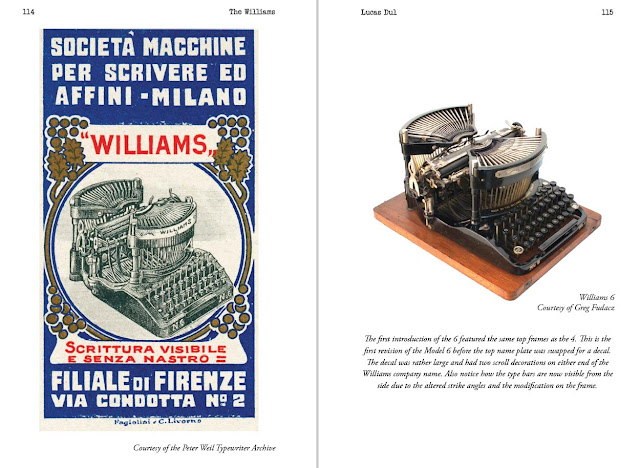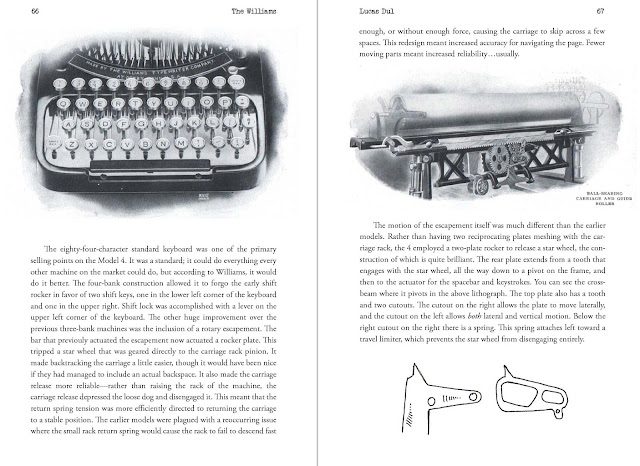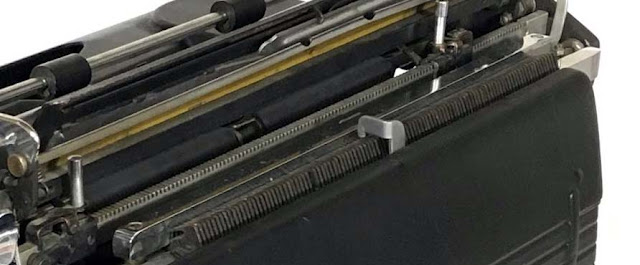A million stories are trembling to be crystallized on the black ribbon of the typewriter.
—Harry Stephen Keeler, The Mechanics (And Kinematics) of Web-Work Plot Construction
Like a musical instrument, a typewriter is a finite thing with infinite possibilities. Here's one way to grasp this truth.
Starting in the mid-1930s, standard typewriters became capable of setting as many tabulator stops on the typing line as the typist wished. Here's an example of a modern tabulator in the back of my 1942 Woodstock.
This is a mechanical memory. A modest pica typing line of 80 spaces can hold 80 bits of memory: each tab stop is either set or cleared, 1 or 0.
80 bits seems ludicrously minimal in our age of terabytes. (A terabyte is roughly a trillion bytes—more precisely, 1,099,511,627,776 bytes. Since there are 8 bits to a byte, that's 8,796,093,022,208 bits.)
But consider how many possible arrangements of the tabulator rack there are: 2 to the 80th power, or 1,208,925,819,614,629,174,706,176. You will never configure your tab stops in all possible ways.
Now, how many possible sequences of characters are there in a line of typing? Again, let's assume an 80-character line. And for simplicity, we'll use only 29 characters: the 26 capital letters of the English alphabet, plus the space, the period, and the comma. The possibilities are 29 to the power of 80, or approximately 9.813859405063193 × 10 to the 116th power. If we're just a little sloppy, we can call it 10 to the 117th power — that is, 1000000000000000000000000000000000000000000000000000000000000000000000000000000000000000000000000000000000000000000000. That number dwarfs the estimated number of atoms in the observable universe.
Now, let's assume you type 125 lines per day for 30 days, which is around the pace necessary to complete NaNoWriMo. (National Novel Writing Month challenges you to write 50,000 words in 30 days. An 80-character line accommodates 13-1/3 five-letter words plus spaces between them. 125 x 30 x 13-1/3 = 50,000.) The possible combinations for your NaNoWriMo novel are roughly (10 to the 117th power) to the 3750th power. It is not possible for anyone to type out all the zeros in this number.
Let's say you keep going at the NaNoWriMo pace, typing 50,000 words a month throughout your adult life. If you type every day for 60 years, that will give you 720 months of work, giving you ((10 to the 117th power) to the 3750th power) to the 720th power possibilities — a number only God can imagine. And that's only the possibilities for one typist.
Admittedly, most of these combinations of characters will be gibberish—but even if there were only a million possible meaningful 80-character sequences (surely there are more), you would still have (1,000,000 to the 3750th power) to the 720th power possibilities for your lifetime typewritten output.
In short, for us finite beings, the possibilities of a typewriter are practically endless. And Keeler's line about "a million stories"? It's a bit of an underestimate.
















